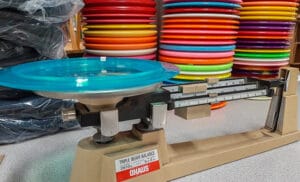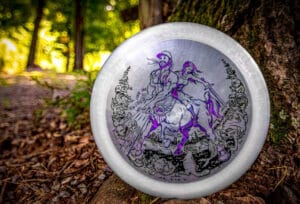Understanding Disc Fade in Disc Golf: Causes and Solutions
Table of Contents
This is one of the most frustrating things beginners experience when they first start playing disc golf. You throw your driver as hard as you can and it immediately dumps left. It seems to go nowhere. You watch other players throw their drives and they seem to glide straight for days, or maybe even flip over to the right and glide beautifully before finishing left. How are their throws so much better than yours?
Before we continue, we should note that we are speaking from the perspective of a right-handed thrower throwing a traditional backhand shot. Beginner lefties will have the same problem with the disc fading too hard to the right. Learning to throw a forehand flick is a different story for a different day on the DGU Blog.
So, why is your disc fading immediately left on you? There are several factors in play. It’s mostly about learning proper form. Part of it can also be a matter of disc selection. Let’s take a look at some of the key things that will affect your disc’s flight path:
Slow Arm Speed
Most beginners will lack arm speed at first. This is usually a result of poor form. Like any new sport you pick up, it usually takes time to build up your confidence and physical skills. Nobody ever hits a homerun on their first baseball swing. Why should you expect to throw your disc 400 feet right away?
Throwing Too Hard
How hard you try to throw and your arm speed aren’t always one and the same. Watch the pros play and it often doesn’t look like they are throwing hard at all. Their excellent form allows them to generate more power. Their throwing motions are so refined after years and years of practice. They are super smooth and they get an extra “whip” at the end that results in next-level power. We recommend slowing your tempo down a bit and not trying to throw too hard. Work on a smooth, flat release first and you will see more consistent flight paths. Over time, you can build up to more arm speed and power.
Release Angle
Perhaps the most common culprit of discs going hard left is the player’s release angle. Most of us tend to naturally have what we call in disc golf a “hyzer” release. This means the disc is tilted down and left when you throw it and basic physics will tell you that the disc will fly on the angle it is thrown. One of the most important things any beginner disc golfer should work on is learning to have a flatter release angle (with the disc coming out level with the ground). It may feel quite unnatural at first, but it is something you must learn if you are going to improve as a disc golfer. Eventually, you can also learn to throw on an “anhyzer” angle, which is when the disc is essentially tilted upward when you release.
Release Point
Another part of the equation is your release point. Even the most experienced disc golfers will sometimes have an “early release” where the disc slips out of their fingertips a little early. This will diminish your power and usually result in the disc dumping out to the left on you. If you commonly suffer from early or late releases (the dreaded “grip lock”), it can also be a sign that your throwing motion is way too rounded. Rather than coming straight back and through the throw, your arm is going out and around. Though some players can still be pretty effective with this type of rounded form, it does make it much harder to achieve a consistent release point.
Disc Stability
Of course, you also have to consider the discs you are throwing. The more you learn about different discs, you will realize they all have different flight characteristics. An Innova Champion Firebird is designed to be very overstable, which means it wants to go hard left on you no matter what. A Valkyrie has a more neutral flight path, so it wants to fly fairly straight (though it will still go left on you if you suffer from any of the form issues above). Then, there are understable discs like a Roadrunner that should turn right for you and give you a nice “S” flight if you throw it properly. These three discs are all 9-speed fairway drivers, but they are specifically designed to do different things when in the air.
Disc Speed
Speaking of disc speed, that is another huge factor that ties right in with number 1 on the list. Too many new players start out trying to throw distance drivers when they just aren’t ready for discs that fast. Fast discs require good form and higher arm speeds to fly the way they are designed to fly. Many beginners will find that they can throw a putter or 5-speed mid-range disc farther than they can throw a 12-speed Star Destroyer.
Beginners will typically get better results from a slower, lighter and more understable disc that doesn’t require as much power or a perfect release angle to fly a bit farther. If you really want to get better, you should practice and refine your throwing form with more neutral discs—with nothing faster than a mid-range or fairway driver (maybe just a putter at first). Learn good form before you start experimenting too much with different disc types, release angles and other things that you might not quite be ready for.
Throwing a disc perfectly straight is one of the hardest things to do in disc golf. If you can master that shot, you can ultimately master any throw in the game!
What's Next?
Need help finding the perfect disc for a specific shot, better accuracy, or more distance? We’re here to help! Just follow the link below to answer a short questionnaire. We’ll send you FREE personalized disc recommendations within 1 business day along with a coupon code for $5 off your next order.
GET PRO TIPS



